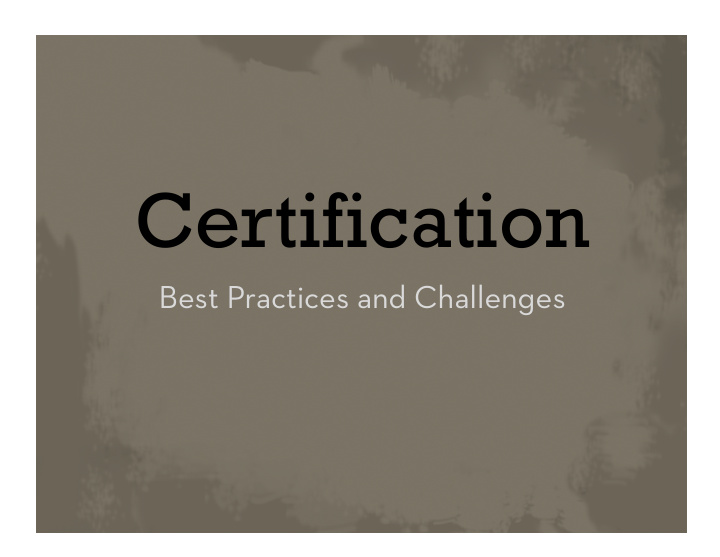



Certification Best Practices and Challenges
Key Considerations Sc Scope ope T Transpar ansparency ency A Accessibility essibility Go Governanc ernance e V Validation alidation M Monit onitoring oring F Fee S ee Structur tructure e C Cons onsumer V umer Value alue C Cons onsumer A umer Awar areness eness
Scope What does this c hat does this certification ertification do and no do and not do t do? ? Lack of recognition/awareness and confusion around what “sustainable fishing” entails
Transparency Is inf s information cle ormation clearly arly comm ommunicat unicated and publicly ed and publicly available ailable? ? From Consumer Reports’ www.greenerchoices.org
Accessibility How do you create a system that is accessible to a range of businesses? Fair trade for all http://www.marcgunther.com/a-schism-over-fair-trade/ http://www.npr.org/blogs/thesalt/2013/04/24/177757797/coffee-for-a-cause-what-do-those-feel-good-labels-deliver http://www.fairtradeusa.org/sites/all/files/wysiwyg/filemanager/standards/FTUSA_MAN_CertificationManual.pdf
Governance How do y w do you ens ou ensur ure thir e third-party d-party independenc independence when the c e when the certification ertification agency is s agency is support upported b ed by br y brands ands? Handles compliance and audits for Fair Trade USA, MSC, FSC, and more… • Financial independence • Fee-for-service independent of volume • Conflict of interest policy and structure http://www.nytimes.com/2013/06/01/us/complaints-abound-in-green- certification-industry.html?ref=johnmbroder&_r=1&
Validation How do you create a validation system that is trustworthy? • Self assessments Self assessments • Peer visits eer visits • Monit onitoring a oring audits udits • What happens t hat happens to tho o those f se found in violation ound in violation? ?
Monitoring How do you create a monitoring system that is not too costly or onerous? • Self assessment every 2 years, audit every 2- 6 years depending on the risk category, peer visits every 2 - 6 years depending on the risk category • 8 fee-based professional agencies perform analysis • Audited annually, certificate lasts 5 years • Companies annually renew the pledge, audits by an independent agency as needed only for those that use the logo • Application with fee, document request and onsite audit, evaluation audits in year 0, 3, 6, and surveillance audit year 1-2 and 4-5
Fee Structure Audit Fees every six years of estimated $3,000 +, and nominal fees every three years Annual membership fees to the CCIC and a one-time licensing fee, based on the company's gross annual sales, required for use of the trademarked logo ($500 to $4,500), no fee for those that don’t use the logo Varies according to geography, corporate form, and size of organization (sales and number of employees), logo free with certification
Consumer Value Measurable/observable return on investment or personal benefits Consumer education, brand awareness and outreach are key Point of sale signage reinforces certification message
Consumer Awareness Cons onsumer umers seem t s seem to be mo o be most f t familiar with se amiliar with seals sponsor als sponsored b ed by f y feder ederal al agencies and that r agencies and that repr epresent fr esent frequently pur equently purchased it chased items ems Energy Star (87%), Recycling (89%) and USDA Organic (62%) Cons onsumer umers seem t s seem to be le o be leas ast f t familiar with se amiliar with seals sponsor als sponsored b ed by non- y non- go government ernmental or al organizations, infr ganizations, infrequent pur equent purchase chase, lo , low use o w use of logo b f logo by y eligible c eligible companies, and no adop ompanies, and no adoption b tion by major c y major companies ompanies Cruelty-free/Leaping Bunny (11%), Marine Stewardship Council (11%) Source: BBMG, “Conscious Consumer Report 2009.”
Additional Considerations Product P oduct Frequent use or availability helps create mass market awareness P Partner artners s NGOs, government, or large retailers able to reach broad audience Logo D ogo Design esign Consistency of message and logo, simple, easy to replicate in a variety of formats and easy to attach to qualifying products Compe ompeting & C ting & Complement omplementar ary S y Standar andards ds
Resources Nassauer, Sarah, “Busted by the Crafs Cops,” The Wall Street Journal , April 17, 2012 Broder Br oder, J , John M., “E ohn M., “Envir vironment onmentalis alists ts’ C ’ Complaint E omplaint Expo xposes R ses Rif B Betw tween ‘ een ‘Gr Green een’ ’ Certification Gr ertification Group oups,” ,” The N he New Y w York T ork Time imes , M , May 31, 20 y 31, 2013 13 Charles, Dan, “Coffee For A Cause: What Do Those Feel-Good Labels Deliver?,” NPR, April 24, 2013 A Schism over Fair Trade, http://www.marcgunther.com, May 13, 2012 BBMG, “Conscious Consumer Report 2009” http://www.greenerchoices.org/
Recommend
More recommend